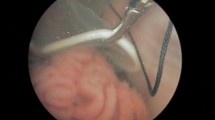Abstract
Current protocols for fetal surgery require cesarean section and partial fetal extraction, both of which impart significant risks to the mother and fetus. Endoscopic fetal surgery is less invasive and will likely reduce some of these risks, but the technical difficulties and feasibility in a primate model have yet to be explored fully. Four pregnant baboons (95 days gestation) were anesthetized, their uteruses exposed via an abdominal incision, and blunt-tipped flanged endoscopic ports inserted. Amniotic fluid was removed, and warmed saline was infused to dilate the uterus. To evaluate instrumentation and wound closure, the tip of the snout was externalized and bilateral cleft lip-like defects made. The lips were then endoscopically repaired by suture (Endostitch, U.S. Surgical) or unique nonpenetrating clips (VCS, U.S. Surgical). The saline was then removed, amniotic fluid returned, and the ports carefully removed. After 4 weeks, the fetuses were delivered and evaluated. Eight cleft lip-like defects were successfully repaired in all four cases. Operative time averaged 83 min. No infections, amniotic leaks, or adhesions developed. Survival was 50% with two fetuses delivering within 48 hours postoperatively: one from preterm labor, the other with fetal demise from retroperitoneal hemorrhage after operative blunt abdominal trauma. We demonstrate the feasibility of endoscopic fetal surgery in primates. The use of blunt-tipped flanged ports provides a fluid tight seal and allows appropriate closure of the fetal membranes, but requires laparotomy and uterine exposure. Distension of the uterus with warmed saline affords a larger operating field, enhancing visualization and instrumentation of the fetus. Grasping the fetus through the exposed uterus gives excellent control for repair. However, such control is also needed in a percutaneous approach. Further instrumentation development is needed to accomplish similar control for the percutaneous approach.
Similar content being viewed by others
Author information
Authors and Affiliations
Additional information
Received: 28 April 1997/Accepted: 18 February 1998
Rights and permissions
About this article
Cite this article
Oberg, K., Robles, A., Ducsay, C. et al. Endoscopic intrauterine surgery in primates. Surg Endosc 13, 420–426 (1999). https://doi.org/10.1007/s004649901004
Published:
Issue Date:
DOI: https://doi.org/10.1007/s004649901004




